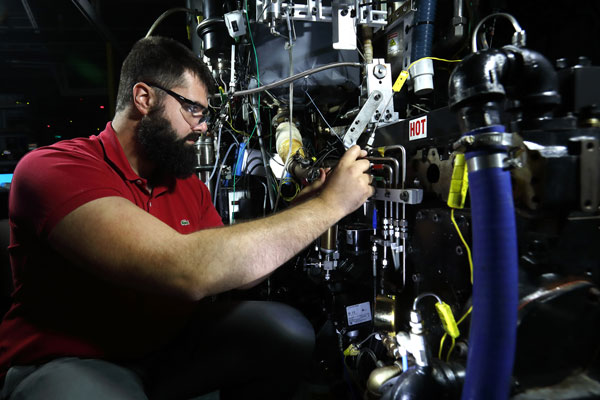Sandia postdoc receives SAE Excellence in Oral Presentation Award for phi-sensitivity research

Understanding the fundamentals of phi-sensitivity, a key fuel property that represents how the autoignition reactivity of the fuel varies with the fuel/air equivalence ratio, will help increase the efficiency and facilitate the development of practical low-temperature gasoline combustion engines, according to research conducted at Sandia’s Combustion Research Facility.
Led by Sandia postdoctoral appointee Dario Lopez Pintor, the research highlights how low-temperature gasoline combustion can lead to substantial efficiency improvements to reduce fuel consumption by 30% compared to conventional gasoline engines, and the importance of phi-sensitivity for making this type of combustion work well.
Dario was recognized for his work at the 2019 SAE World Congress. He received an SAE Excellence in Oral Presentation Award for his paper, “Phi-Sensitivity for LTGC Engines: Understanding the Fundamentals and Tailoring Fuel Blends to Maximize This Property.”
The work was funded by Co-Optima, an R&D collaboration between DOE, nine national laboratories, several universities and industry organizations.
The work was conducted in conjunction with John Dec, Senior Scientist and principal investigator of the low-temperature gasoline combustion laboratory in Sandia’s Combustion Research Facility, and former Sandia postdoctoral appointee Gerald Gentz.
“The paper identifies the fundamental chemical reactions responsible for phi-sensitivity,” Dario said. “The paper examines how phi-sensitivity behaves when varying pressure, temperature, concentration of fuel and concentration of oxygen.”
The paper also explores the potential of developing a fuel that has both high phi-sensitivity and a high octane-rating compared to the values for a regular-grade gasoline, which would make it an improved fuel for both LTGC and modern spark-ignition engines.
Importance of phi-sensitivity in LTGC engines
Phi-sensitivity has important benefits for the operation and control of LTGC engines. A fuel is phi-sensitive if its autoignition reactivity varies with the fuel/air equivalence ratio (phi).
“For an engine that works with a non-uniform air-fuel mixture, different regions of the combustion chamber will have different fuel/air equivalence ratios that will ignite at different times, leading to a sequential autoignition event that provides several benefits,” Dario said. “Some of these benefits are extending the maximum allowable engine load, increasing the efficiency, easing the control of the combustion and improving combustion stability.”
The first part of the paper describes the fundamentals of phi-sensitivity, identifying the chemical kinetics responsible for it and explaining how it behaves when varying the operating conditions.
“I like to think of phi-sensitivity like any other fuel property — its value changes with the working conditions,” Dario said. “Viscosity can be a good analogy. Is the wax of a candle viscous? It depends on the temperature. Cold wax is very viscous, but melted hot wax is not. It’s the same with phi-sensitivity.”
“Is gasoline phi-sensitive? It depends on the operating conditions,” he said. “Phi-sensitivity is a chemistry-dependent property, so it depends not only on temperature, but also on pressure and mixture composition. When we say that a fuel is not phi-sensitive, it means that is not phi-sensitive under typical engine conditions.”
The second part of the paper explores the potential of developing a fuel that has both high phi-sensitivity and high octane.
“Designing a custom gasoline-like fuel blend is like developing a new cooking recipe,” Dario said. “You want to identify the perfect combination of ingredients (hydrocarbons) to obtain the optimum result. When you cook, you blend condiments and different ingredients with a combination of flavors to give you the desired results. Similarly, when we blend a fuel, we combine hydrocarbon classes to give a combination of properties that gives us the desired result.”
Work continues
Dario said this work can help other researchers define the adequate operating conditions to take advantage of the phi-sensitivity of a fuel.
“Now, we know how we should modify the working conditions of the engine to enhance the phi-sensitivity and, more importantly, we know why this works,” he said.
The work will also help future research on fuel development. “We showed that a fuel can show both high phi-sensitivity and a high-octane number,” Dario said. “Understanding the phi-sensitivity fundamentals is important to design new fuels that would be suitable for both LTGC and modern spark-ignition engines.”
Dario said the research shows that it is possible to design a regulation-compliant, gasoline-like fuel blend that simultaneously increases the phi-sensitivity and the octane number, to make an improved fuel suitable for both LTGC and modern spark-ignition engines, something that many automotive researchers thought might not be possible prior to the team’s work.